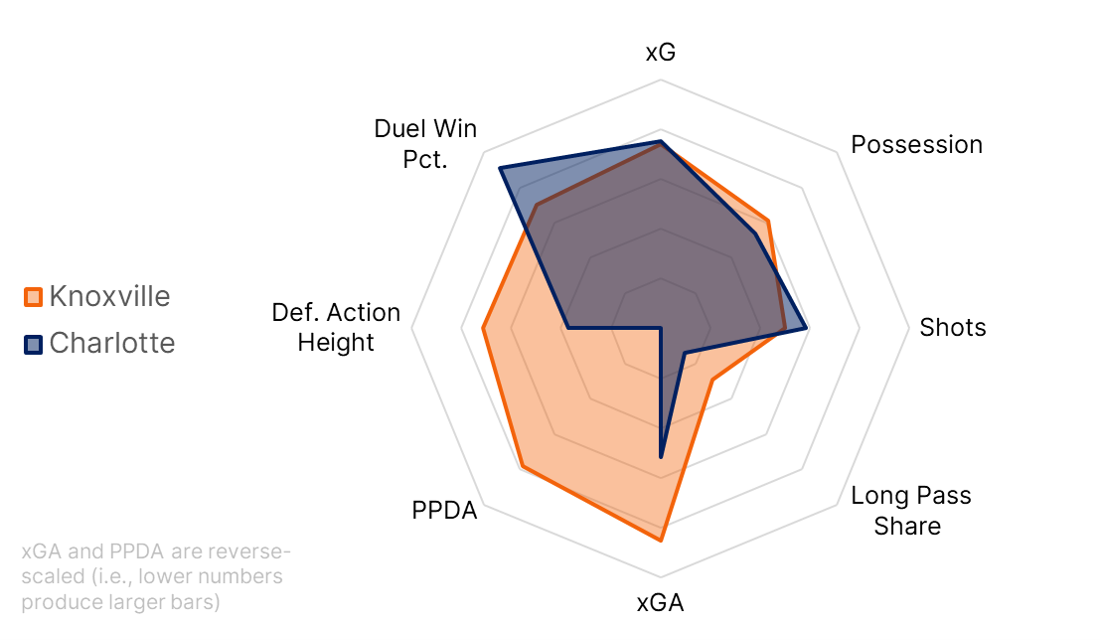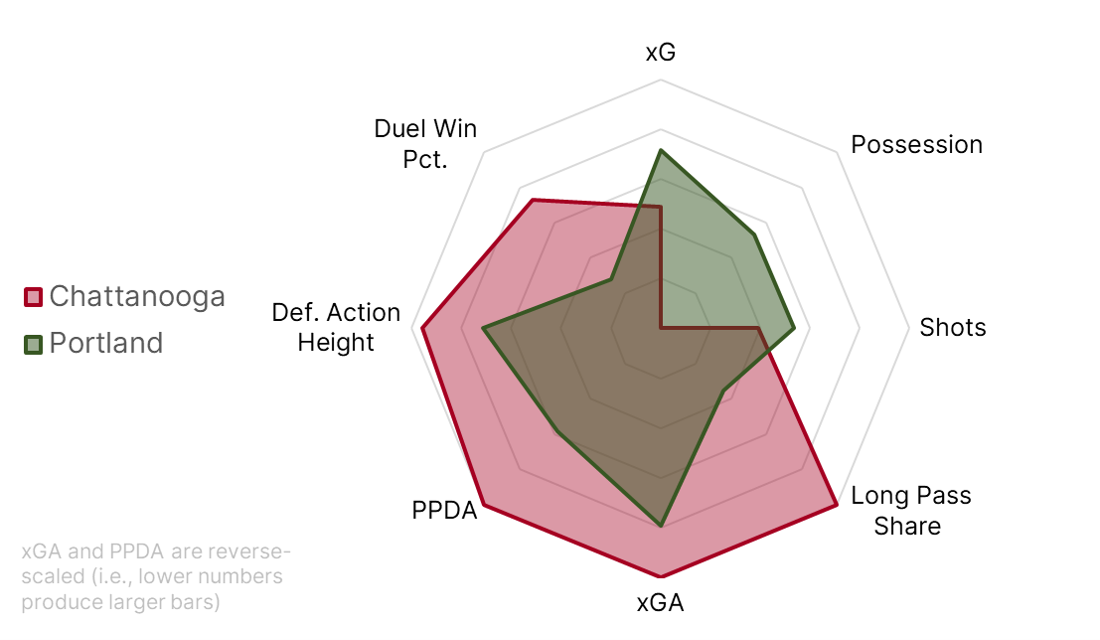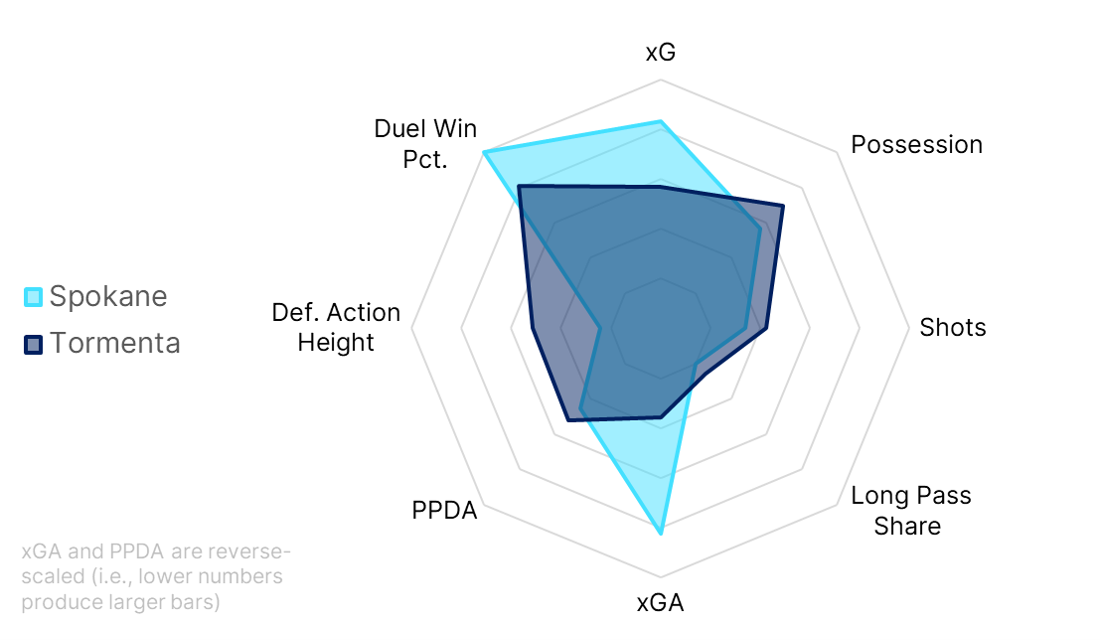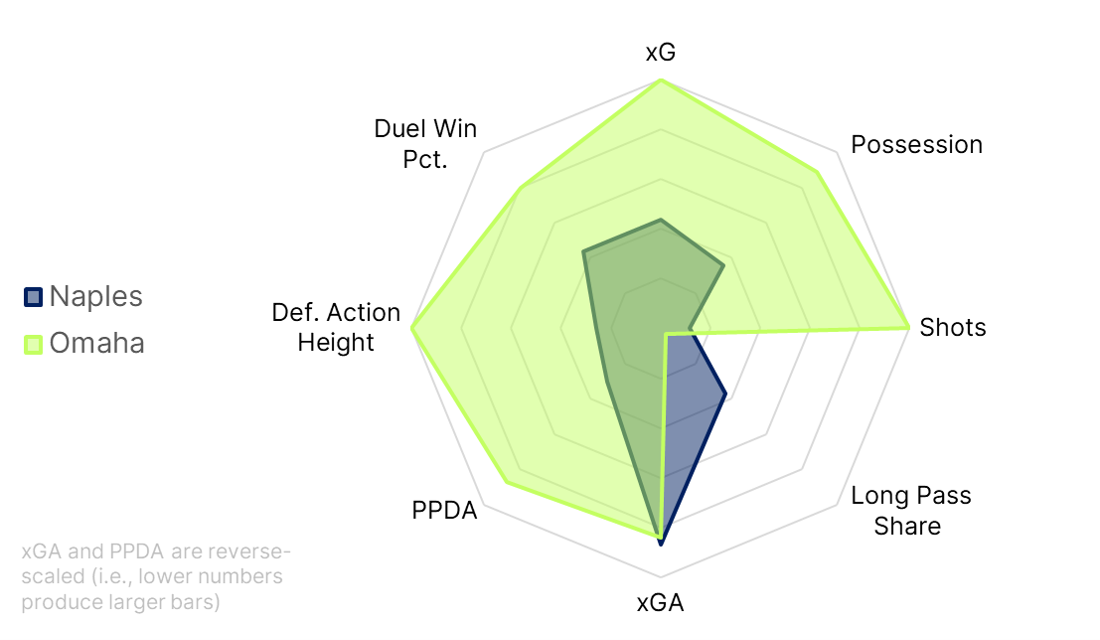USL League One Playoff Preview, 2025
Breaking down the first round of the 2025 USL League One postseason
The 2025 USL League One season felt like a passing of the torch. Expansion clubs stole the headlines for much of the year, and much of the “old guard” – Greenville, Richmond, Madison, etc. – failed to reach the postseason. The majority of playoff teams hired their coach within the last calendar year, including two clubs whose midseason managerial change saved the season.
In other words, it’s classic League One chaos. The division has never been more competitive, so I’m analyzing each first-round playoff matchup to see who has an edge.
Each preview section will include three things: a statistical profile assessing outcomes (e.g., xG) and style (e.g., long passing, passes against per defensive action), a longform profile of each club’s system, and a motivating clip explaining how the match might be won or lost.
Without further ado, let’s dig in.
(1) One Knox - (8) Charlotte Independence
By the Numbers
Team Profiles
Knoxville is, perhaps, the most balanced team in League One. Want to play over the top and dominate in second-ball situations? One Knox can do it. If you like an elite low-block defense punctuated by a lightning-quick counter, Ian Fuller’s side fits the bill. They’ve grown into a fearsome possession offense to boot.
Fuller hasn’t received enough praise in his first season in Tennessee, having taken a relatively consistent core and given it new life in 2025. Knoxville mostly runs a 4-2-3-1ish shape, though that can morph into a four-man pressing line through the midfield or into a possessive back three. No matter what, One Knox is intent on dominating where the match is played.
You might look at the club’s modest final-third recoveries (2.1 per match) and assume that Fuller doesn’t prioritize the press, but that’s untrue. Knoxville allows merely 7.2 passes per defensive action (third-best in the league) with an average intervention arriving 43 yards upfield (fourth-best). In other words, the high press is meant to force bad passes and facilitate midfield recoveries – and it does so at a high level.
With the ball, Knoxville narrows their left winger to accommodate fullback Stuart Ritchie on the overlap. Thanks to that deployment, the left back has completed 48 crosses and created 48 chances this season; both numbers are up 50% year-over-year. In turn, the width of the 3-2-4-1 attacking formation has allowed other players in the One Knox system to evolve.
Kempes Tekiela is the poster boy for that growth. As a pure No. 9 last season, Tekiela looked like one of the smoother finishers in the league and projected to be a Golden Boot candidate for 2025. Instead, he’s re-emerged as a do-it-all No. 10. Tekiela has the ball-moving skill and long-range precision to addle defenses, and he’s equally able to anchor Knoxville’s long-from-the-back initiation style.
None of it would be possible without an elite defense anchored by Jordan Skelton and Sivert Haugli. The former is a perennial all-league candidate, whilst Haugli has often played in the midfield throughout his career. Together, they’re a hulking duo good for a cumulative duel win rate in excess of 60% and nearly 140 touches per game. In every sense, they set the table for one of League One’s true contenders.
Charlotte, meanwhile, is defined by consistency you could set your watch to. They’ve made the playoffs in every full season since Mike Jeffries returned to the helm midway through 2019, and they’ve done so with gradual evolution. While the 2025 regular season ended with some wobbles, you can never count the Independence out in a single-elimination format.
As in years past, Charlotte isn’t afraid to defend in a mid-low block and tends to be patient with the ball. They’ve again leaned into a phase-based shape, usually going 5-2-3 defensively before fanning their right side into a possessive 4-2-4. For less disciplined teams, that gambit might be risky. That’s rarely the case in Charlotte thanks to a veteran back line and domineering pivot.
Bachir Ndiaye and Omar Ciss remain an impressive give-and-take combination through the pivot, and the defense behind them is full of poise. Nick Spielman played all of 2,700 available minutes in the regular season, while Clay Dimick – another didn’t-miss-a-minute iron man – stepped up to the plate as the hybrid center back/fullback option to his right. The Independence kept adding as the year went on, strengthening their defensive corps with familiar USL faces like Tobi Adewole and Amal Knight.
Up top, Christian Chaney hasn’t missed a beat at age 31, scoring 12 goals and adding more than four aerial wins per game on the best duel win percentage (52%) of any League One striker. His anchor-like presence allows Jon Bakero (nine assists) to float between lines, and it facilitates that phase-based shifting. When Charlotte needs to get expressive in transition, it’s Chaney and Bakero that make it happen.
Is Charlotte sexy? Maybe not, but they’re rock solid if nothing else. In the playoff environment, that means the Independence shouldn’t be taken lightly.
In a Clip
Here, you’re seeing the collision of Knoxville’s flexible final-third shape and Charlotte’s 5-2-3 alignment in low block. If the Independence want to pull off an upset, they’ll need to be sharper than in the clip above, where One Knox’s combination of central superiority and dangerous width in a “three-box-three” is overwhelming.
At the onset of the play, Sivert Haugli possesses at the left-sided center back spot and finds an angle into a tucked-in Gio Calixtro, swooping inside from the wing. Because Charlotte had flexed into a 5-1-3-1 with midfielder Omar Ciss high, the penetration forces one of their center backs to step as a makeweight up the middle as Calixtro receives.
It won’t be enough of a response. The winger will hit Kempes Tekiela at his feet, allowing the star attacker to dribble against the momentum of the defense and loose an overlapping Stuart Ritchie up the left. Ritchie’s cross will create a point-blank header that goes just a bit high.
The lesson here is one of discipline. The Independence will probably spend a large amount of time in a lower block, but if their pivot is solid, it’ll allow the back five to stay shapely. Get that far, and you may frustrate Knoxville into conceding a game-deciding transition move.
(2) Chattanooga Red Wolves - (7) Portland Hearts of Pine
By the Numbers
Team Profiles
I shouldn’t be trusted to make preseason predictions, and Chattanooga is a case in point. I pegged the Red Wolves as the worst team in League One with a bullet; they spent all of 2025 flirting with the Players’ Shield instead. Scott Mackenzie took a group of unheralded players and turned them into the hardest team to play against in the entire USL.
Chattanooga’s system – whether based in the season-long 3-4-3 or the late-breaking 4-4-2 – is extremely physical and vertical. Their 26% long pass share tops the league. With an average vertical passing distance of 12.7 yards, the Red Wolves are the most direct team in the history of League One! They also lead the division with nearly 3,300 duel attempts this year.
When the Red Wolves are hunting for a lead in an even game, they’re underrated for their skill with the ball on the ground. Chattanooga initiates long much of the time, but that’s a tool to tilt the pitch. As soon as the Red Wolves settle, they’re allowing wingbacks like Jordan Ayimbila (1.6 successful dribbles per game) and Yanis Lelin (1.3 dribbles, 1.3 chances created) to combine up the sideline. Meanwhile, this team is excellent at holding a firm line at halfway to create short-field opportunities.
When they need to defend in low block, Chattanooga is immaculately organized. They lead the league in xG against and clearances, fueled by the impenetrability of what’s typically been a 5-4-1. Pair Ualefi’s veteran poise from the No. 6 spot with the mix of size, athleticism, and nous that center backs like Declan Watters and Eric Kinzner provide, and you’re never going to have it easy against the Red Wolves.
End-of-year experimentation with the 4-4-2 notwithstanding, this team has mostly stayed consistent throughout 2025. Now, the question is whether Mackenzie’s next-man-up, defense-driven system can get the job done in the postseason.
Portland is more than just an attendance and branding darling. In their first season of action, Hearts of Pine have become League One’s premier press-and-possess team. It’s a system that will be immediately familiar to anyone who knew Bobby Murphy’s style in MLS Next Pro, and it’s allowed Portland to highlight some of the best technical attackers in their division.
Hearts of Pine base their system out of a back four, prioritizing line-breaking directness within their build patterns to challenge opposing defenses. The goal is to get into the final third as quickly as possible – and to stay there on the back of a high-flying 4-2-4ish press.
Portland has rotated their attacking line more than any other team in League One – a necessity given the intensity of the system – and is rife with energetic, skillful options. Ollie Wright (17 goal contributions, 66 touches per game) is the best of the bunch coming off the left side, where he’s capable of creating his own shots and tearing defenses asunder. His ability to connect with overlapping left back Nathan Messer is Hearts of Pine’s most reliable pattern, but they’re just as likely to let Masashi Wada cook as the No. 10 or loose striker Titus Washington on the break.
In the pivot, Michel Poon-Angeron and Mikey Lopez might be Portland’s most important players. You can trust their possessive recycling skills without a shadow of a doubt, granting Hearts a crucial safety net in the final third. There are moments where League One’s more physical teams can push the pair around in second-ball situations (see a recent three-game losing streak against teams like Knoxville and Omaha), but even those instances have become increasingly rare thanks to the sharpness of the counterpress.
At their best, no offense in the league is as dynamic as Portland’s. In a single-elimination format, that might just be enough to push Hearts of Pine over the edge into legitimate title contention.
In a Clip
Can Portland stay structured in second-ball situations and stop Chattanooga from getting into the final third? If so, they’ve got a great chance of advancing, but Hearts of Pine will need to improve in instances like you’re seeing above.
In the wake of a long pass, Portland tries to claim the ball in the midfield. Both of their center mids – an unlikely pairing of Masashi Wada and Patrick Langlois in this case – push upfield in hopes of regaining. Instead, Ualefi claims possession for the Red Wolves and quickly touches the ball into the path of Matthew Acosta, his partner in the pivot.
While Chattanooga used a 3-4-3 shape in this match, their breakout formation in the clip is remarkably similar to the baseline 4-4-2 that’s prevailed at the end of the season. Two strikers push forward against a backtracking defense, and Jordan Ayimbila flies upfield on the overlap. The Portland pivot can’t recover after having committed in the knockdown situation, and Chattanooga gets a shot off from the edge of the box.
Hearts of Pine will be using a first-choice No. 8s in the first round, and that will help in these very situations. Portland led league one with more than 1,400 recoveries for a reason, but if they lack recovery structure while pressing that advantage, they’re going to have a long night in East Ridge.
(3) Spokane Velocity - (6) South Georgia Tormenta
By the Numbers
Team Profiles
Spokane is a model of orderly, controlling soccer. Among League One’s elite, there’s a real tendency toward a more direct and physical style. By contrast, Leigh Veidman’s Velocity excel when they can keep the ball on the ground and break down opposing defenses – or when they can sit in mid-block and stop you from doing the same.
That’s not to say Spokane is one-note. This Velocity team is underrated for their stubborn defending in a 4-4-2 framework, and they’re one of League One’s more varied teams on the break. Much of that joy starts with Luis Gil, who’s racked up double-digit goal contributions on 90th percentile chance creation. Once Spokane regains, they tend to drive into Gil’s feet and let the 31-year-old go to work. By then, he’ll have runners like Shavon John-Brown streaking ahead to take defenses to task.
Still, it’s Spokane’s in-possession patterns that stand out. This team wants to shift into a 3-2-5 when they’ve got the ball, pushing one fullback (usually right-sided Lucky Opara) high while keeping the other (i.e., left back Derek Waldeck) low. Doing so spreads defenses while also providing a five-strong resting base. It also activates Waldeck and David Garcia as back-end passers, highlighting their full penetrative ranges.
Garcia ought to be in the conversation for Defender of the Year, but he hasn’t done it alone. Spokane is comfortable sitting in a mid-to-low posture, hence why their average defensive action has come barely 39 yards upfield, the second-deepest mark in the division. Still, led by Garcia (64% duel win rate), a physical pivot anchored around Andre Lewis (5.3 recoveries per match), and goalkeeper Carlos Merancio (7.6 goals prevented), that 4-4-2 base is impossibly hard to break down.
On the other side, I’m not necessarily saying Tormenta is the dark horse of the League One playoffs, but their recent form makes it hard to think otherwise. Since Mark McKeever took over for longtime manager Ian Cameron, South Georgia has been one of the best teams in the entire division.
Where Cameron instilled a back-four system focused on patient possession, McKeever runs a 3-4-3 with far more freedom and big-play upside. It was obvious on opening day that Tormenta had a wealth of playmakers, but they’ve only recently found consistent success by letting them improvise within a deceptively ornate structure.
The give-and-take across South Georgia’s front line is nigh impossible to stop. Niall Reid-Stephen has 20 goal contributions to his name and might be the premier self-creating, transitional dynamo in League One. Mason Tunbridge (a wonderfully technical dribbler) and Yaniv Bazini (a classic hold-up No. 9) are excellent table-setters between the lines, while Sebastian Vivas is as dangerous a change of pace as you could imagine off the bench.
Tormenta excels on the break, but they’re underrated against set defenses because of Gabriel Alves and Oscar Jimenez’s contributions at the wingback spots. Jimenez likes to tuck narrow like a proxy No. 8 in build situations, while Alves’ wider positioning stretches defenses and opens up channels for Reid-Stephen. Together, they’ve combined to hit 10.2 final-third entry passes per game since the start of September, combining penetrative abilities in build with overlapping excellence in the full-blown attacking 3-2-5.
The back five is highly athletic, bolstered by the mid- and late-season additions of Makel Rasheed and Justin Malou. What was a position of weakness in Statesboro is suddenly a strength, setting the table for all the fluidity further ahead. It’s yet more evidence of how Tormenta has hit their stride and why they’ve got a real chance at making noise this November.
In a Clip
If you want to beat Tormenta, you need to control their attack. Deny South Georgia the time and space to activate their best offensive players, and you’ve got a fighting chance of winning. That’s exactly what Spokane did earlier this month, holding Mark McKeever‘s side to just 0.38 xG because of plays like you’re seeing above.
As Tormenta takes a throw from within their own third, Spokane hedges their 4-4-2 against the sideline. The primary striker marks the nearest defender, while Andre Lewis closes down on a center mid and continues that aggressive run directly at wingback Oscar Jimenez. Still, Lewis’ step from the pivot doesn’t come at the expense of the Velocity structure, allowing for an easy recovery when Jimenez is forced into a hoof.
Spokane tries to push the tempo upon regaining, playing over Tormenta’s lines before their 5-2-3 can get back into shape. That’s unsuccessful, and another break is potentially on. Again, though, Spokane doesn’t let it happen.
Left back Derek Waldeck smartly marks Mason Tunbridge as he tucks to receive; right back Lucky Opara gets low to maintain the three-man transition block. The Velocity are able to safely corral the outlet pass before it creates a modicum of danger.
This is the formula on Sunday: if Spokane defends with this level of poise, they’ll set themselves up to take care of business against the hottest offense in League One.
(4) FC Naples - (5) Union Omaha
By the Numbers
Team Profiles
Unlike most expansion teams, Naples hasn’t undergone big swings in their debut season. Their longest winning streak was three matches; their longest losing streak maxed out at two. Matt Poland knew how he wanted to play on opening day, and that’s essentially remained unchanged for six full months.
What does the system look like? Naples typically runs a 4-2-3-1, but they’re adaptable in practice. Maximizing semi-transitional, short-field moments is Poland’s primary goal, but his side is equally adept at absorbing pressure in a mid-low block and has allowed just 0.78 non-break xG per match in the run of play.
You’ll often see one of the center mids (i.e., Marc Torrellas) step higher into a 4-1-4-1 pressing line, allowing Chris Heckenberg to sweep up as a single pivot player. The dynamics up the middle have only improved as Kevin O’Connor has settled back in as the No. 10; he’s winning nearly two headers per game and is a constant pest for opposing ball-carriers. When that group can force turnovers, it’s off to the races with striker Karsen Henderlong at the center of it all.
Henderlong has cooled down as 2025 has come to its denouement, but he’s still got 14 goals in league play and nabbed a final-week brace. The variety of finishing stands out, but the No. 9’s ability to anchor transition offense is even more important to Naples’ alchemy. Henderlong’s movement in behind is highly intelligent. He knows when to hold play up, allowing for quick wingers like Jayden Onen and Andres Ferrin (3.9 shots per game between them) to find opportunities. It’s a trident-like front that’s centered around Henderlong’s complete profile.
None of Naples’ success would be possible without their time-tested defensive core. Brecc Evans and Jake Dengler might be the best center back duo in the division, and Lalo Delgado is as steady as they come at goalkeeper – not to mention the trophy he and Evans won together with Northern Colorado in 2024. As long as that group plays to their level, Naples will be a tough out in the postseason.
It’s easy to forget that Omaha was in minor crisis mode entering the summer. At that point, Dom Casciato had just decamped for the Championship and Los Búhos sat below the playoff line. Vincenzo Candela made changes to get Omaha back on track, but he also trusted his core; this team had elite underling numbers even when they struggled, and now they look like a juggernaut.
Union Omaha’s 2024 title relied on a 5-2-3ish system anchored around stars like Steevan Dos Santos at striker and Pedro Dolabella as a do-it-all anchor between the lines. Candela-ball is far more equitable. Omaha usually runs some version of a 4-2-4, a shape defined by interchange and fluidity that can take any opponent to task.
I’ve already written about Max Schneider until I’m blue in the face, but suffice to say that Omaha might have the best midfield pivot in League One. Those No. 8s aren’t necessarily asked to run the show as progressors. Instead, they’re circulators on the edge of the final third. Omaha mixes up their distribution from the back, but however they activate their 2-2-4-2 attacking look, it relies on Schneider and partners like Laurence Wootton or Brandon Knapp to set the table.
Offensive options abound. Left back Charlie Ostrem led League One with a staggering 10 assists, and he delights in combining with Mark Bronnik up their shared flank. Bronnik might be the best young player in the league, but he’s not guaranteed to start with do-it-all loanee Ryan Becher vying for minutes. On the right, Prosper Kasim is a Championship-caliber creator, and he’s flourished as Omaha’s primary hub in the halfspace. Up top, this club has at least three forwards you’d trust in a playoff setting.
It took time for this defense to find chemistry, but Brent Kallman and Samuel Owusu – both new signings over the offseason – have been rock solid this fall. The burden on that partnership is lightened by a superb counterpress and the recovery skills of the pivot, but Owusu and Kallman still deserve their flowers.
It’s hard to poke any holes in this Omaha team. No club is as versatile in attack, so able to dominate territory and minimize opposing control. In the playoff setting, that’s an invaluable skill, and it might let Los Búhos pull off a repeat.
In a Clip
Omaha’s attack relies upon an ability to overload the box, hit a slew of crosses, and maintain the field tilt with post-clearance recoveries. For FC Naples, that means the defensive core needs to stay tight – as a matter of preservation, and as a way to set up counterattacking opportunities.
Here, Naples starts in a mid-low 4-4-2 posture, applying ball pressure onto Charlie Ostrem and Laurence Wootton to force them backwards. Omaha is able to find an edge into right back Dion Acoff after resetting, but they’re still facing down the brunt of Naples’ numbers.
Two things stand out as Acoff starts to push upfield. For one, he’s contested at every step by winger Jayden Onen, whose defensive effort denies a clean crossing angle. Centrally, Chris Heckenberg – Naples’ truest No. 6 – drops below the level of the rest of the midfield to clog space in case Acoff tries for a quick cutback.
Omaha is able to fill the lanes of the opposing back four, but they can’t cross in. However, those overwhelming numbers immediately set up the counterpress after Acoff gives the ball away. Naples can’t play out of their own zone, Prosper Kasim intercepts from the right wing, and a shot is on.
For Los Búhos, creating as many situations like this as possible is the route to success; it’s death by a thousand cuts. For Naples, it’s the giveaway that represents a turning point. Take these situations, turn them into zone exits that find Karsen Henderlong’s feet, and you’ll give yourself a chance to eat up on the break.
For more: check out The USL Show’s League One preview and my playoff discussion on United Soccer Lounge.





